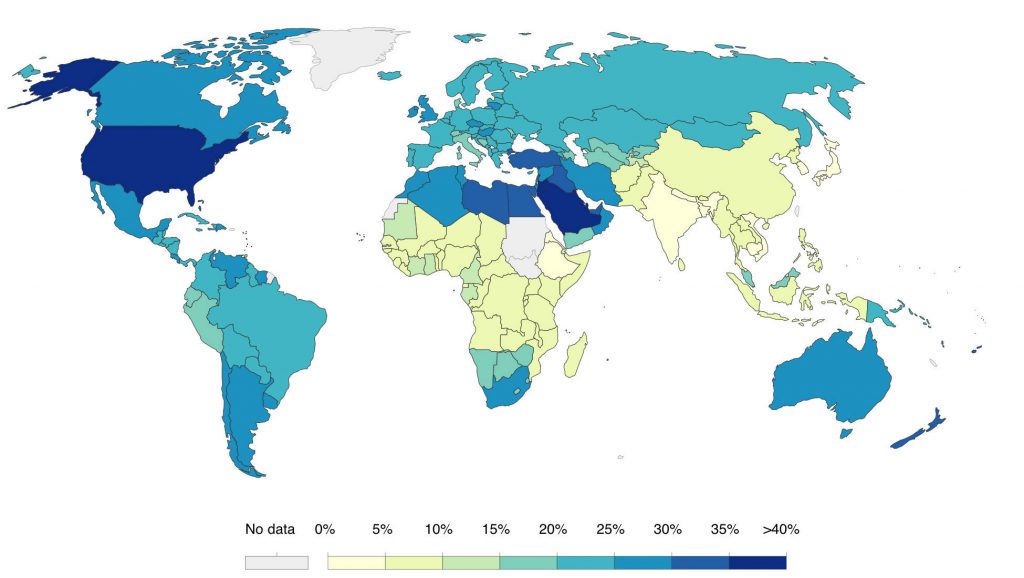Obesity places a significant burden on people affected, increasing their risk of unintended health consequences,5 and reducing their life expectancy.6

Percentage of adults aged 18+ defined as having obesity in 2016 (people with obesity defined as BMI >30)7
Despite the scientific community recognising obesity as a multifactorial chronic disease which requires long-term management,8,9 it is often considered to be the responsibility of the individual by governments, healthcare systems and even people with obesity.10,11

Rising obesity levels have also had an adverse effect on society and economic prosperity, causing a decrease in economic activity through loss of productive life years,12 and by placing increasing demands on healthcare systems.13

Approximately 46% of people with a BMI<40 have at least five related complications, rising to 55% of individuals with a BMI>60.5 These complications can include type 2 diabetes, cardiovascular disease and certain cancers which all require a substantial level of care and medication.2
1World Health Organization. 2018. Obesity and overweight.[Online] Available at: http://www.who.int/mediacentre/factsheets/fs311/en [Accessed February 2019].
2Yuen, M.M., et al. (n.d.). A systematic review and evaluation of current evidence reveals 236 obesity-associated disorders. Massachusetts General Hospital & George Washington University. [Poster presentation]
3Kelly, T et al. 2008. Global burden of obesity in 2005 and projections to 2030. International Journal of Obesity. 32: 1431-1437
4The GBD 2015 Obesity Collaborators. 2017. Health effects of overweight and obesity in 195 countries over 25 years. The New England Journal of Medicine; 377 (1): 13-27
5Agborsangaya, C.B., et al. 2015. Multimorbidity in a prospective cohort: prevalence and associations with weight loss and health status in severely obese patients. Obesity (Silver Spring); 23(3):707-12
6Prospective Studies Collaboration. 2009. Body-mass index and cause-specific mortality in 900 000 adults: collaborative analyses of 57 prospective studies, Lancet; 373(9669):1083-96.
7WHO. 2019. Our World in Data. “Obesity & BMI”. Available at: https://ourworldindata.org/obesity Last accessed: February 2019
8The Canadian Medical Association. 2015. CMA recognises obesity as a disease [Online] Available at https://www.cma.ca/En/Pages/ cma-recognizes-obesity-as-a-disease.aspx [Accessed October 2018]
9American Medical Association House of Delegates, 2013. Recognition of obesity as a disease. Resolution 420 (A-13). 16th May 2013. Chicago, USA.
10Henderson, E. 2015. Obesity in primary care: a qualitative synthesis of patient and practitioner perspectives on roles and responsibilities. Br J Gen Pract; 65 (633): e240-e247
11World Health Organisation: Controlling the global obesity epidemic [Online] Available at http://www.who.int/nutrition/topics/obesity/en/ [Accessed October 2018]
12Fontaine, K.R., et al. 2003. Years of life lost due to obesity. Journal of the American Medical Association; 289 (2): 187-193
13Wang, Y.C., et al. 2011 Health and economic burden of the projected obesity trends in the USA and the UK, Lancet; 378(9793):815-25.






